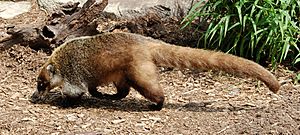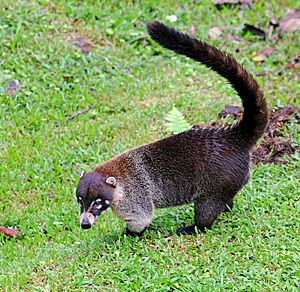White-nosed coati facts for kids
Quick facts for kids White-nosed coati |
|
|---|---|
 |
|
| in Costa Rica | |
| Conservation status | |
| Scientific classification | |
| Genus: |
Nasua
|
| Species: |
narica
|
| Subspecies | |
|
|
 |
|
| The native range of the white-nosed coati. Note: Its Colombian range is restricted to the far northwest (see text). | |
| Synonyms | |
|
Viverra narica (Linnaeus, 1766) |
|
The white-nosed coati (Nasua narica), also known as the coatimundi, is a species of coati and a member of the family Procyonidae (raccoons and their relatives). Local Spanish names for the species include pizote, antoon, and tejón, depending upon the region. It weighs about 4–6 kg (8.8–13.2 lb). However, males are much larger than females: small females can weigh as little as 2.5 kg (5.5 lb), while large males can weigh as much as 12.2 kg (27 lb). On average, the nose-to-tail length of the species is about 110 cm (3.6 ft) with about half of that being the tail length.
Contents
Habitat and range


White-nosed coatis inhabit wooded areas (dry and moist forests) of the Americas. They are found at any altitude from sea level to 3,000 m (9,800 ft), and from as far north as southeastern Arizona and New Mexico, through Mexico and Central America, to far northwestern Colombia (Gulf of Urabá region, near Colombian border with Panama). There has been considerable confusion over its southern range limit, but specimen records from most of Colombia (only exception is far northwest) and Ecuador are all South American coatis.
Coatis from Cozumel Island have been treated as a separate species, the Cozumel Island coati, but the vast majority of recent authorities treat it as a subspecies, N. narica nelsoni, of the white-nosed coati. They are smaller than white-nosed coatis from the adjacent mainland (N. n. yucatanica), but when compared more widely to white-nosed coatis the difference in size is not as clear. The level of other differences also support its status as a subspecies rather than separate species.
White-nosed coatis have also been found in the U.S. state of Florida, where they are an introduced species. It is unknown precisely when introduction occurred; an early specimen in the Florida Museum of Natural History, labeled an "escaped captive", dates to 1928. There are several later documented cases of coatis escaping captivity, and since the 1970s there have been a number of sightings, and several live and dead specimens of various ages have been found. These reports have occurred over a wide area of southern Florida, and there is probable evidence of breeding, indicating that the population is well established.
Feeding habits
They are omnivores, preferring small vertebrates, fruits, carrion, insects, snakes, and eggs. They can climb trees easily, where the tail is used for balance, but they are most often on the ground foraging. Their predators include boas, raptors, cats, and tayras (Eira barbara). They readily adapt to human presence; like raccoons, they will raid campsites and trash receptacles. They can be tamed easily, and have been verified experimentally to be quite intelligent.
Behavior
While the raccoon and ringtail are nocturnal, coatis are active by day, retiring during the night to a specific tree and descending at dawn to begin their daily search for food. However, their habits are adjustable, and in areas where they are hunted by humans for food, or where they raid human settlements for their own food, they might become more nocturnal. Adult males are solitary, but females and sexually immature males form social groups. They use many vocal signals to communicate with one another, and also spend time grooming themselves and each other with their teeth and claws. During foraging times, the young cubs are left with a pair of babysitters, similar to meerkats. The young males and even some females tend to play-fight. Many of the coatis will have short fights over food.
White-nosed coatis are known pollinators of the balsa tree, as observed in a study of a white-nosed coati population in Costa Rica. The coati were observed inserting their noses into the flowers of the tree and ingesting nectar, while the flower showed no subsequent signs of damage. Pollen from the flowers covers the face of the coati following feeding, and later disseminates through the surrounding forest following detachment. Scientists observed a dependent relationship between the balsa tree, which provides a critical resource of hydration and nutrition to the white-nosed coati when environment resources are scarce, and the coati, which increases proliferation of the tree through pollination.
See also
 In Spanish: Nasua narica para niños
In Spanish: Nasua narica para niños




